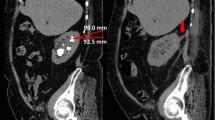Abstract
Background and purpose
Safe and successful puncture of the kidney’s collecting system is essential for acute therapy of hydronephrosis or as part of percutaneous nephrolithotomy. The procedure is technically challenging and might lead to major complications. We describe the feasibility of a laser guidance system and three-dimensional puncture planning in the endourological operation room.
Materials and methods
An Uro Dyna-CT of the biological model was performed with the Artis Zee® Ceiling (Siemens Medical Solutions, Erlangen, Germany) to gain multiplanar reconstructions. 10 punctures were performed with the syngo iGuide® laser guidance system. Puncture success was depicted with antegrade contrast filling of the collecting system and fluoroscopic control. Puncture time, tract length, and fluoroscopy time was documented.
Results
Data acquisition (8 s) and 3D rendering (48 s) was possible in approximately 1 min. Median time for planning the punctures was 7 [5–15] min. Median puncture time was 4.6 [2–10.2] min. Median tract length was 4.96 [4.33–6.5] cm. Median fluoroscopy time was 0.4 [0.2–1] min. 9 of 10 punctures were successful. A second puncture was needed to gain access to the collecting system in one case, and one puncture was broken up.
Conclusion
The tested laser guidance system was feasible to perform successful percutaneous punctures of the kidney in this ex vivo study. Handling was intuitive and time within acceptable limits. Due to the requirement of multiplanar reconstructions with higher radiation exposure to the patient than with standard fluoroscopy, this technique should be limited to complex cases.


Similar content being viewed by others
References
Alken P, Hutschenreiter G, Gunther R, Marberger M (1981) Percutaneous stone manipulation. J Urol 125(4):463–466
Fernstrom I, Johansson B (1976) Percutaneous pyelolithotomy. A new extraction technique. Scand J Urol Nephrol 10(3):257–259
Goodwin WE, Casey WC, Woolf W (1955) Percutaneous trocar (needle) nephrostomy in hydronephrosis. J Am Med Assoc 157(11):891–894
Ritter M, Krombach P, Michel M-S (2011) Percutaneous stone removal. Eur Urol Suppl 10(5):433–439
de la Rosette J, Assimos D, Desai M et al (2011) The clinical research office of the endourological society percutaneous nephrolithotomy global study: indications, complications, and outcomes in 5803 patients. J Endourol 25(1):11–17
Steinberg PL, Semins MJ, Wason SE, Matlaga BR, Pais VM (2009) Fluoroscopy-guided percutaneous renal access. J Endourol 23(10):1627–1631
Mozer P, Conort P, Leroy A et al (2007) Aid to percutaneous renal access by virtual projection of the ultrasound puncture tract onto fluoroscopic images. J Endourol 21(5):460–465
Desai M (2009) Ultrasonography-guided punctures-with and without puncture guide. J Endourol 23(10):1641–1643
Osman M, Wendt-Nordahl G, Heger K, Michel MS, Alken P, Knoll T (2005) Percutaneous nephrolithotomy with ultrasonography-guided renal access: experience from over 300 cases. BJU Int 96(6):875–878
Soria F, Delgado MI, Sanchez FM, et al (2009) Effectiveness of three-dimensional fluoroscopy in percutaneous nephrostomy: an animal model study. Urology 73(3):649–652 [discussion 652–644]
Hacker A, Wendt-Nordahl G, Honeck P, Michel MS, Alken P, Knoll T (2007) A biological model to teach percutaneous nephrolithotomy technique with ultrasound- and fluoroscopy-guided access. J Endourol 21(5):545–550
Akpek S, Brunner T, Benndorf G, Strother C (2005) Three-dimensional imaging and cone beam volume CT in C-arm angiography with flat panel detector. Diagn Interv Radiol 11(1):10–13
Quek LH, Pua U, Chua GC, Tsou IY (2009) Computed tomography fluoroscopic-guided percutaneous spinal interventions in the management of spinal pain. Ann Acad Med Singapore 38(11):980–988
Huber J, Wegner I, Meinzer HP et al (2011) Multimedia article. Navigated renal access using electromagnetic tracking: an initial experience. Surg Endosc 25(4):1307–1312
Meyer BC, Peter O, Nagel M et al (2008) Electromagnetic field-based navigation for percutaneous punctures on C-arm CT: experimental evaluation and clinical application. Eur Radiol 18(12):2855–2864
LeMaitre L, Mestdagh P, Marecaux-Delomez J, Valtille P, Dubrulle F, Biserte J (2000) Percutaneous nephrostomy: placement under laser guidance and real-time CT fluoroscopy. Eur Radiol 10(6):892–895
Ritter M, Krombach P, Martinschek A et al (2012) Radiation exposure during endourologic procedures using over-the-table fluoroscopy sources. J Endourol 26(1):47–51
Brabrand K, Aalokken TM, Krombach GA et al (2004) Multicenter evaluation of a new laser guidance system for computed tomography intervention. Acta Radiol 45(3):308–312
Jacobi V, Thalhammer A, Kirchner J (1999) Value of a laser guidance system for CT interventions: a phantom study. Eur Radiol 9(1):137–140
Conflict of interest
For the development of the endourological intervention table, a cooperation contract exists with Siemens Health Care Solutions.
Author information
Authors and Affiliations
Corresponding author
Rights and permissions
About this article
Cite this article
Ritter, M., Rassweiler, MC., Häcker, A. et al. Laser-guided percutaneous kidney access with the Uro Dyna-CT: first experience of three-dimensional puncture planning with an ex vivo model. World J Urol 31, 1147–1151 (2013). https://doi.org/10.1007/s00345-012-0847-8
Received:
Accepted:
Published:
Issue Date:
DOI: https://doi.org/10.1007/s00345-012-0847-8




